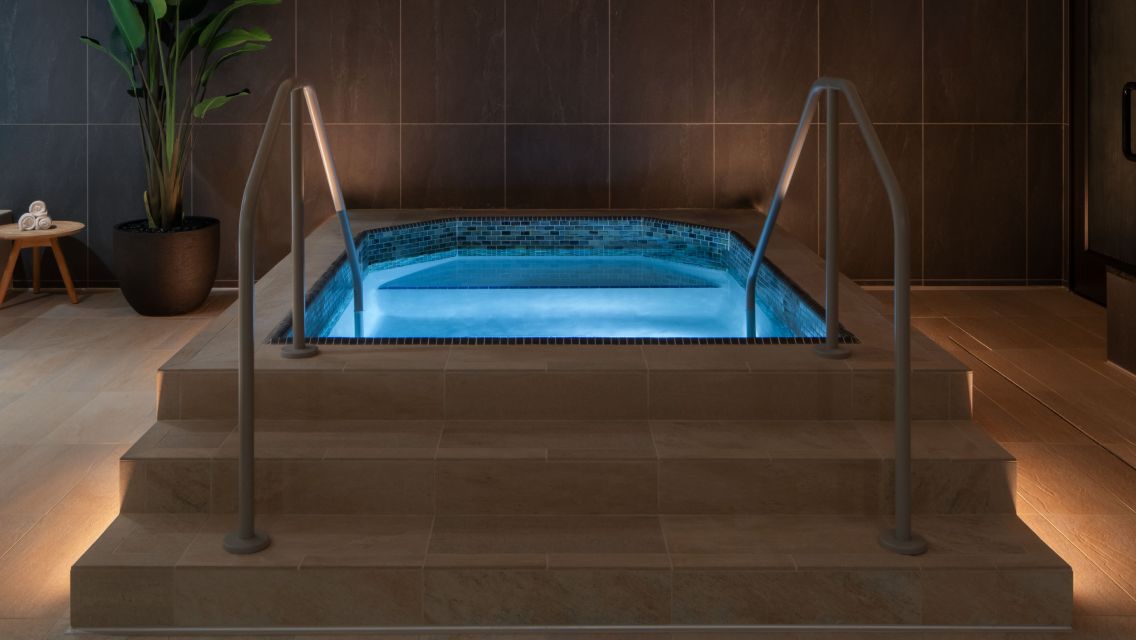The practice of jumping into an ice-cold body of water is a centuries-old tradition that has surged in popularity over recent years thanks to the trend of “polar bear plunging.” While that’s certainly a bragworthy challenge, there are benefits to considering a dip in cold water as a regular habit versus a once-a-year feat: Cold-water exposure can boost your energy, improve your mood, alleviate inflammation, increase mitochondria production, aid in recovery, and more. (Learn More: “The Health Benefits of Cold Conditioning.”)
Many health clubs offer cold tubs or cold plunges to help you reap these benefits as part of a daily routine. To help you maximize your experience, Danny King, Master Trainer and director of performance and recovery at Life Time, offers some guidance.
Start by Assessing Your Goals
Before plunging in, it’s helpful to first determine what you hope to gain from the experience so you can adjust the timing of your plunge, as applicable.
Morning Energy Boost
Immersing yourself in cold water right after waking up can help combat grogginess and enhance alertness to get you energized for the day . Cold stimulates the sympathetic nervous system (your fight-or-flight response), which initiates an instant shot of adrenaline. As you leave the water, there’s a release of endorphins that can make you feel good, helping to set a positive tone for your day ahead.
“These invigorating effects also help to prepare your body for physical activity, making it an excellent addition to your pre-workout routine,” King suggests.
Mental Resilience
Submerging your body into ice cold water is a form of “good stress,” similar to how we think of exercise, which challenges your body’s stress response. You can build mental resilience by learning to remain focused in your body and using your breath during the moments of discomfort.
“Training your mind and nervous system to tolerate the cold and remain composed is a practice that fosters greater resilience and mental clarity over time,” says King.
Post-Workout Recovery
Submerging yourself in cold water triggers your body to direct blood flow toward your core to maintain its core temperature. As the body warms up over time, blood vessels expand, causing blood to circulate from the core out to the rest of the body. This helps redistribute fresh oxygenated blood throughout tissues, facilitating recovery and reducing inflammation.
King advises, however, to avoid the cold plunge after strength training.
“If your fitness goals are rooted in muscle growth, cold plunging after a strength-training session may slow down the essential inflammation processes necessary for muscle repair and development,” he says. “Instead, you may want to try spending a few minutes in a hot tub or sauna. Recent research highlights the advantages of heat exposure post strength training to speed up muscle repair and growth. You can also try using a pneumatic-compression device, massaging targeted muscles, and ensuring adequate protein intake after workouts for optimal muscle recovery.”
Restful Sleep
Some find it helpful to cold plunge before bed as it can help lower heart rate and regulate body temperature, which may enhance deep sleep and REM cycles. However, others find it heightens vigilance, making it difficult to fall asleep because of the drop in core temperature.
“Plunging before bed can be a hit or miss, so I suggest experimenting with it,” King says. “It’s a personal preference that may or may not suit everyone.”
Get Ready to Plunge
Follow these step-by-step instructions to make the most of your cold plunge experience.
1. Set the water temperature between 45 and 55 degrees F.
Optimal benefits from cold plunging are typically found from being in water that is below 60 degrees F, with the mid-50s being the ideal range. (Most Life Time clubs set their cold plunge temperatures to between 45- and 50-degrees F.) Some may assume the cooler the temperature the better, but King advises against anything below 45 degrees F — there’s no concrete evidence that colder temperatures provide additional health benefits.
2. Submerge up to your neck as quickly as possible.
The quicker you submerge yourself into the cold water, the harder it is to change your mind and back out, says King.
“For someone brand new to cold plunging, gradually easing into the water isn’t necessarily a bad approach — but those who dip in slowly often end up not fully committing to the plunge,” he remarks. “The faster you submerge, the faster you can get past the initial shock, making the experience more manageable overall.”
While you can choose to target specific body parts to alleviate inflammation in that limb post-workout, for example, King advocates for full body submersion rather than partial submersion, as it rewards you with all the benefits a plunge has to offer.
Having the water reach up to your neck also helps target the vagus nerve, which plays a key role in overall health and stress regulation. The vagus nerve extends from your brain to your gut, so immersing yourself up to your neck can effectively activate the fight-or-flight response. If you only put your legs or lower torso into the water, it won’t create enough of a sympathetic response to thoroughly feel the effects.
“Don’t think about it — just jump right in,” King says. “Let the cold water do its job, and don’t worry about anything else. You’ll feel so much better before you know it.”
3. Set a timer according to your level of experience.
If you’re new to cold plunging, start with shorter durations — around 30 seconds — to manage the initial shock response and ease into it. The intensity of the discomfort typically subsides after the first 30 seconds, so it’s crucial to push through this threshold.
As you feel more comfortable with plunging over time, gradually extend the duration to challenge your mental resilience and maximize physical benefits. The ideal duration typically falls between two to five minutes. While pushing beyond this time allotment is possible, there isn’t research showing additional benefits past five minutes. Sticking to five minutes or less also helps minimize the risk of hypothermic symptoms.
4. Focus on your breath.
Controlling your breathing calms both the mind and body, allowing you to relax in times of discomfort. This is especially useful during the first 30 seconds of plunging when your body enters fight-or-flight mode. Focusing on your inhales and extending your exhales brings about a calming effect, signaling to your body that it’s safe and there’s no need to panic.
5. Move around.
Moving around during a cold plunge can enhance the anti-inflammatory benefits you experience. King recommends softly paddling your arms and legs every once in a while to pull the cold water toward your skin. “Light and gentle movement prevents a warm layer of water from forming around your body, ensuring that cold water continuously touches your skin,” he says. This increases your body’s thermoregulation mechanism, which can help accelerate recovery time and inflammation reduction.
6. Naturally adjust back to a stable temperature.
When it’s time to emerge from the plunge, allow your body to naturally adjust back to a stable temperature instead of immediately seeking warmth.
“This gradual adjustment can trigger the production of brown fat in your body,” King says. “This type of fat is more metabolically active and can aid in calorie burning and heat generation through a process called thermogenesis. This practice not only helps your body adapt better to temperature changes, but also supports overall metabolic health in the long run.”




